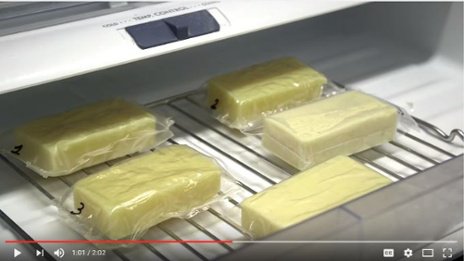 When in the supermarket, manyfoods meats, breads, cheeses, snacks seem to come wrapped in plastic packaging. Not only does this create a lot of non-recyclable, non-biodegradable waste, but thin plastic films are not great at preventing spoilage. And some plastics are suspected of leaching potentially harmful compounds into food. To address these issues, scientists in the United States are now developing a packaging film made of milk proteins and it is even edible!
When in the supermarket, manyfoods meats, breads, cheeses, snacks seem to come wrapped in plastic packaging. Not only does this create a lot of non-recyclable, non-biodegradable waste, but thin plastic films are not great at preventing spoilage. And some plastics are suspected of leaching potentially harmful compounds into food. To address these issues, scientists in the United States are now developing a packaging film made of milk proteins and it is even edible!
The protein-based films are powerful oxygen blockers that help prevent food spoilage. When used in packaging, they could prevent food waste during distribution along the food chain, says research leader Peggy Tomasula, D.Sc.And spoiled food is just one issue. Current food packaging is mainly petroleum-based, which is not sustainable. It also does not degrade, creating tons of plastic waste that sits in landfills for years.
To create an all-around better packaging solution, Tomasula and colleagues at the U.S. Department of Agriculture (@USDA) are developing an environmentally friendly film made of the milk protein casein. These casein-based films are up to 500 times better than plastics at keeping oxygen away from food and, because they are derived from milk, are biodegradable, sustainable and edible. Some commercially available edible packaging varieties are already on the market, but these are made of starch, which is more porous and allows oxygen to seep through its microholes. The milk-based packaging, however, has smaller pores and can thus create a tighter network that keeps oxygen out.
Although the researchers first attempt using pure casein resulted in a strong and effective oxygen blocker, it was relatively hard to handle and would dissolve in water too quickly. They made some improvements by incorporating citrus pectin into the blend to make the packaging even stronger, as well as more resistant to humidity and high temperatures.
After a few additional improvements, this casein-based packaging looks similar to store-bought plastic wrap, but it is less stretchy and is better at blocking oxygen. The material is edible and made almost entirely of proteins. Nutritious additives such as vitamins, probiotics and nutraceuticals could be included in the future. It does not have much taste, the researchers say, but flavourings could be added.
The coatings applications for this product are endless, says Laetitia Bonnaillie, Ph.D., co-leader of the study. We are currently testing applications such as single-serve, edible food wrappers. For instance, individually wrapped cheese sticks use a large proportion of plastic we would like to fix that.
Because single-serve pouches would need to stay sanitary, they would have to be encased in a larger plastic or cardboard container for sale on store shelves to prevent them from getting wet or dirty.
In addition to being used as plastic pouches and wraps, this casein coating could be sprayed onto food, such as cereal flakes or bars. Right now, cereals keep their crunch in milk due to a sugar coating. Instead of all that sugar, manufacturers could spray on casein-protein coatings to prevent soggy cereal. The spray also could line pizza or other food boxes to keep the grease from staining the packaging, or to serve as a lamination step for paper or cardboard food boxes or plastic pouches. The U.S. Food & Drug Administration recently banned the perfluorinated substances that used to coat these containers, so casein coatings could be a safe, biodegradable alternative.
Bonnaillie says her group is currently creating prototype film samples for a small company in Texas, and the development has garnered interest among other companies, too. The group plans to keep making improvements, and she predicts this casein packaging will be on store shelves within 3 years.
The researchers presented this work recently atthe 252nd National Meeting & Exposition of the American Chemical Society (ACS)the worlds largest scientific society
For more stories on bio-based industry developments like this…
15 key recommendations for your bio-based business in 2016.





